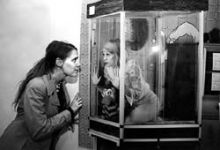Visitors of Kyiv’s Center of Contemporary Art under the Kyiv- Mohyla Academy National University were luckier than those invited to a reception at the UN headquarters in Manhattan, commemorating the admission of Switzerland to the United Nations. Those in Manhattan, according to AP, were treated to Swiss chocolates and presented with as traditional Swiss watches. That same day in Kyiv, a group of Swiss artists offered the Ukrainian audience a look at their national art, free of all stereotypes.
According to the curator of Bernhard Bischoff exhibit “Not Only Chocolate,” the main emphasis in modern Swiss art is on the author’s self-expression. The exposition at the Center of Contemporary Art represents nine artists and measures up to this concept. The Swiss authors seem to invite the viewer to return to childhood, the happiest and freest time in everyone’s life. The best way to do so is by playing a game, so Monica Studer and Christof van den Berg built a website with a hotel where everyone can have a room free of charge. Erve Graumann created a virtual assistant (maybe an alter ego). “Artist” Raul Picktop on the screen is in a perpetual quest for his own style. Now he plays the guitar, then paints a picture — and you can have a hard copy, using the printer right beside the computer. On the opening day, HervО Graumann, assisted by visitors, created a picture made up of names. Visitors with expressive Ukrainian names were invited to sign on the “canvas” where a cloud was to sweep across, an oak tree to grow or a magpie to perch. Franti я cek Klossner portrayed his own head of ice and titled it “Melting Me.”
Andrea Loux offered a children’s game to be played by both visitors and heroes of her photos. On her way from Berlin to Kyiv, the woman artist had stopped for several days in various cities, among other things to sit in her friends’ wardrobe or under a table for an hour or two. While she was there, the friends were to compose a text which she would take with her. Chantal Michelle in her photo-pictures turns into a doll being part of a shop interior selling curiosities or kitsch, or simply junk.
The exposition also had a surprise for the visitors. Erik Dettviler and Bernhard Guviler offered their view of Kyiv. Huwiler used the age-old trick of leaving a camera at a place chosen at random. The camera rotated, taking pictures of the Shevchenko Boulevard alley or a small public garden by St. Volodymyr’s Cathedral. Erik Dettwiler presented something even more original, a 42 min. video film titled “Who Owns the City.” Interviews with four women as an attempt to reveal complex social and political links developing at the Ukrainian capital in the decade of independence. The film was demonstrated at a Swiss art gallery and said to have been a success.
The RILEX Group (Mari- Antoinette Kiarenza, Daniel Hauzer, Daniel Croptier), using ordinary vegetable crates, explained how the price of art can change; that art has a price only when someone is interested in it. Paper tags on the boxes read “1 apiece,” “Free” and “Junk.” The irony of life is that disposing of the boxes no one wants to buy will cost a lot. Loss of interest in a search for something new, for a game to play, loss of childish ingenuousness is also a dear price to pay; it is best never to have to pay it to life, consider the Swiss artists.







